Athena: Greek Goddess of Wisdom and the King of Chaturanga
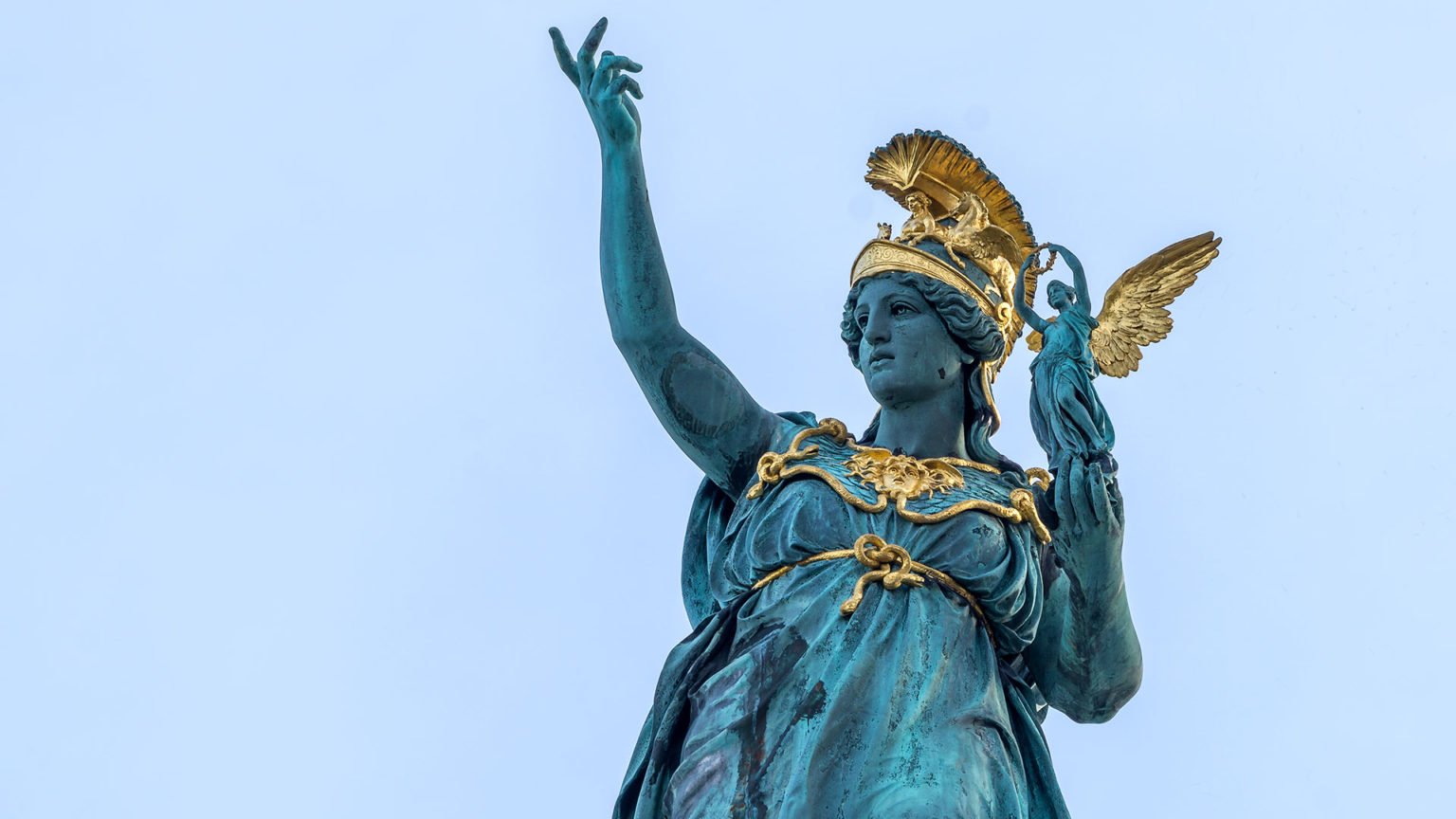
Athena is the Greek goddess of wisdom, handicraft and warfare. She is the personification of science, philosophy and art in Ancient Greece. Insofar as, wisdom includes all the areas of knowledge, talents and usefulness, Athena was frequently depicted as the most benevolent, helpful and honorable of all the gods and goddesses. She was the patroness of Perseus, Theseus, Odysseus and Heracles, whom she encouraged and aided in their adventures. Ares himself submitted to her majestic sagacity, unable to win on the battlefield against her. As the goddess of wisdom, Athena was the most important “headache of Zeus”. In fact, she embodied the political axiom for the progress of humanity in Ancient Greece. Furthermore, Athena also seems to be the King of Chaturanga, and the representation of the sublime Good in the ancient political system of the Ideal State, which stayed undiscovered for the philosophers and archaeologists of the Modern Age.
The Birth of Athena
The goddess Athena came into the world in a very unusual way. Gaia and Uranus foretold Zeus that his first wife, the goddess Metis would give birth to children wiser than their father. Thereafter, they would overthrow him, bringing down his rule as the supreme god of Olympus.
The Thunderer felt frightened to death after having heard such a prophecy and decided to avoid his fate. He deceived and swallowed Metis in a shape of a water drop. Soon afterwards he felt a terrible headache. He suffered for a long time, but finally asked his son Hephaestus to cut off his head.
The god of forge fulfilled his father’s request and cut his head open. For sudden from the slashed head of Zeus jumped out the goddess Athena. Fully armed and outstanding, in a bright shining helmet, with a spear and a splendid shield. Beautiful and majestic she stood before the Olympians. Her eyes glittered with wisdom and might, her face and body emitted unearthly beauty.
After Zeus, Athena became the most powerful among the gods of Olympus. She embodied the wisdom and strength of ideas, the force of creativity and intelligence. Only to her alone Zeus used to entrust his aegis. The Greeks honored the goddess Athena as the patroness of wars and heroes, cities, arts and crafts.
In her fashion of female goddess, Athena was also known as “Parthenos” (Virgin). Insofar as she was one of the three goddesses, along Artemis and Hestia, considered as virgin in Greek mythology. She chose celibacy as a way of life. Therefore, no hero or man on earth could boast that his wife had been the goddess Athena. However, the goddess helped and encouraged many heroes: Perseus, Theseus, Heracles and Odysseus.
Athena’s sacred animals
But not only warriors needed Athena. As the Greeks thought, she gave people wisdom and knowledge, teaching them arts and crafts. Therefore, many Greek intellectuals venerated Athena as the sublime embodiment of intelligence. Philosophers, scientists, ancient physicians, sculptors, poets and other artists admired the goddess of wisdom.
On the other hand, the sacred animals of Athena had been the owl and the snake, the wisest creatures among all the animals.
Athena was also the patroness of women’s crafts. She taught needlework and weaving to the young maidens of Greece. She loved her students to be diligent and creative. In fact, she enjoyed people admiring the creations of their own hands and loathed the arrogant needlewomen who believed themselves to be more skillful than her! The story of Arachne serves as a reproof to this sort of arrogant behavior.
Athena and Arachne
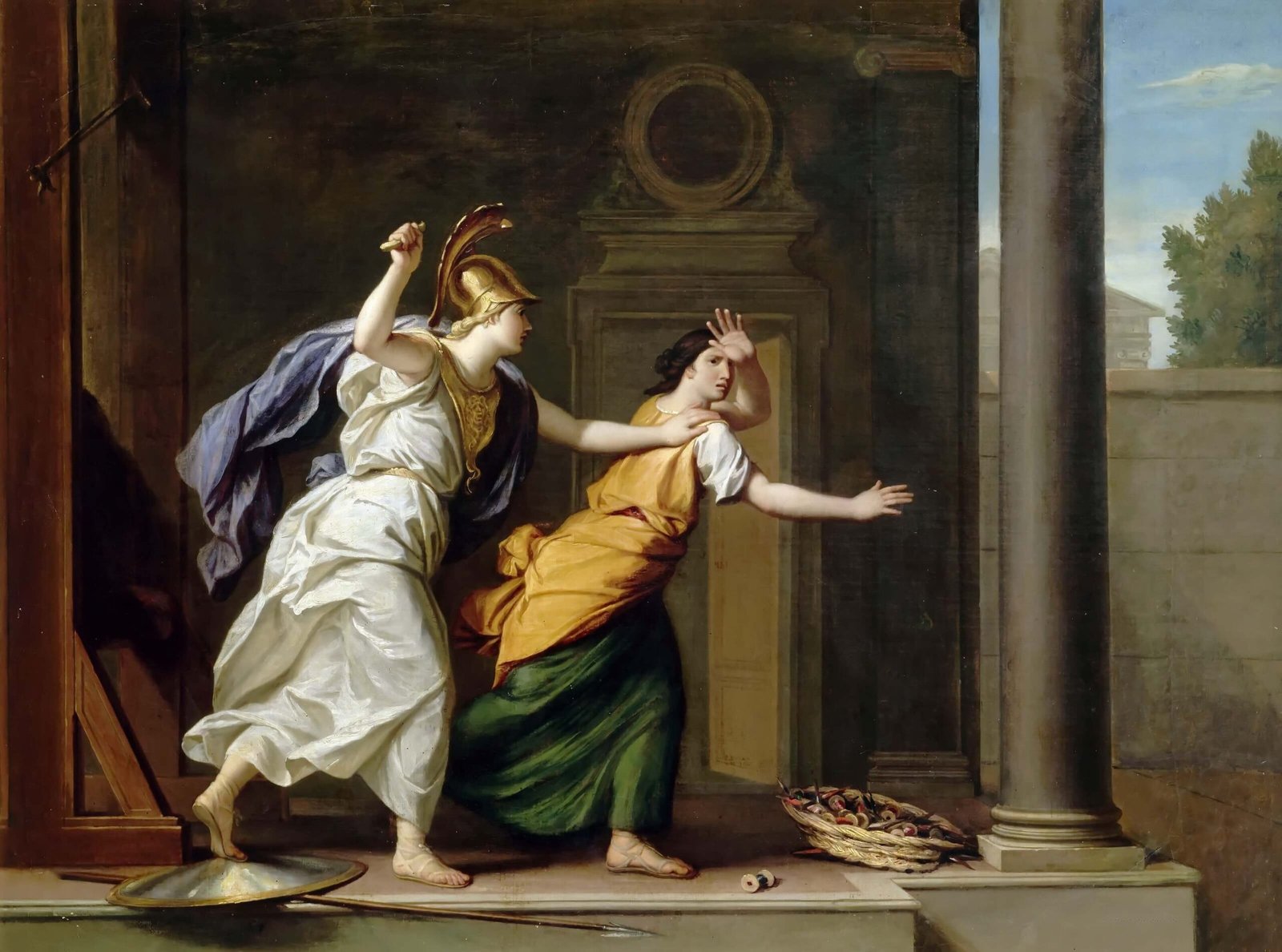
According to Ovid’s Metamorphosis Arachne was a shepherd’s daughter. Thus she began weaving, being a child and became a very skillful weaver. The cloths she wove were so transparent as the air, and none of the mortals had ever managed to surpass her impressive skill. Therefore, Arachne became too proud of herself and bragged being a greater expert, than the goddess Athena.
She offended the patroness of arts, so much that she appeared before her, disguised as an old woman. Athena proposed her to stop boasting, but the young weaver didn’t change her mind. Thus the goddess had manifested herself in her full splendor and set up a contest between them.
Arachne didn’t lose her sight, when she saw Athena in her full glory. In actual fact she chose precisely the topic of divine transformations (“Metamorphoses” means “Transformations” in Ancient Greek) for the tapestry. Immediately afterwards she had depicted not only Zeus and Poseidon adopting another physical shapes to seduce women. She also represented Apollo, Dionysus and Cronus, trying to trick maidens into romance.
Otherwise, the goddess Athena had chosen to represent the conceited, arrogant mortals, being punished by Hera and Zeus. She depicted different characters, who dared to affirm being more attractive than the Thunderer and his wife. Athena represented them being punished and transformed into mountain ranges, birds and statues. These images surrounded the central one, where the goddess Athena had represented herself, winning the patronage of Athens against Poseidon.
According to Ovid, the work of Arachne resulted to be more perfect and beautiful. Therefore, the goddess Athena went into a rage and ripped her tapestry into pieces, streaking her head with a shuttle. Ashamed and shaken, the young knitter had suicided, by hanging herself, as if it was the end of the world.
No one had induced or obliged her to kill herself. However, Athena didn’t forgive the maiden. She splashed Hecate’s juice on Arachne and turned her into a spider. So she could be fond of weaving webs all along her weak pathetic life.
The Meaning of Arachne by Ovid
The story of Arachne looks like a stain on the splendid reputation of Athena. However, Ovid didn’t want or manage to denigrate the goddess (probably with an artistic purpose of truth) and once again the philosophical meaning just had been strengthened in the whole course of the myth.
In fact, the story of Arachne symbolizes the hate of average people towards the great ideals of heroism, freedom and truth. The way how the small distort the perfection and its values, behaving like a vain evil people, who mislead the message of the great.
The ideologies of strength should be criticized and forbidden, so the notion of free personality could be defenseless and die.
In fact, the mediocrities will fill the world with empty and psychotic ideas. Perhaps, with the purpose to impose their herd morality upon everyone. The false artists will do as the spider of tyranny, weaving its web of public idiocy and weakness.
“The Arachne” break to cry, when they hear the hidden meaning of truth, since someone had surpassed them! The sophists and other prostitutes of knowledge misled the way of Aristotle and served as a great example of such a comedy!
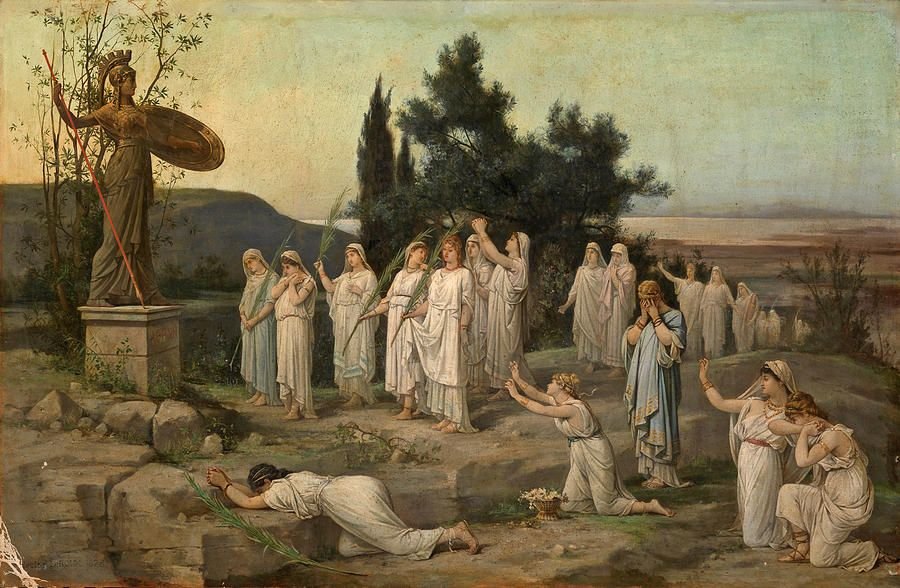
Henceforth along human history, simple citizens acted like a herd, defending the supremacy of their spiteful ideologies. They forced everyone to obey religions, rites and beliefs about surrender, forbidding and killing the glimpse of truth and ingenuity.
That being so, Arachne represented different transformations of the gods, as a symbol of her criticism and disapproval for the male Olympians and the goddess Athena. She criticized the gods, using vapid and depraving scenes, in order to extol the might of vulgarity over perfection. Arachne behaved like an envious tyrant, who wanted to defame the virtues of Apollo, Dionysus and Poseidon.
It was nor Prometheus bringing the fire to people, neither Zeus condemning humanity to live without fire. Arachne didn’t represent the persecution of Leto by the terrible dragon of draconian justice. As a matter of fact, the young weaver criticized Olympus in a very irrelevant, indecent way. She extoled the power of vice and psychotic intentions, which can impose their rule over the world of great ideas.
Arachne had criticized exceptional personalities, comparing them to Zeus. Trying to tell that Apollo, Dionysus and Poseidon are so vile as the golden chain of the man. That Hera should rule the world, killing all the heroes in order to subjugate the way of the male power. The suffering of Dionysus and Apollo’s mother resulted to be justified for Arachne. Insomuch as Hera embodied the despotism of nullity, that cherished so much the envious persons as Arachne.
On the other side, according to the modern perspective of life Arachne would choose to depict perfectly the shape and smell of a lavatory in order to call it art and laugh over the true artists. This way she laughed at good criticism and great artists. In fact, she dreamed about the ordinary and irrelevant topics prevailing over the great masterpieces and awesome ideas.
For such a purpose the Arachne build the web of mediocrities and spiders who attack the genius artists. The weak mock constantly at their meaningful works and ideals of the great. The mediocrities impose the triumph of decadent vulgarity in human society and promote it all around the world.
“The daughters of Pegasus dictate sweetest songs” Heroides 15-21 by Ovid.
Therefore, the hate of Arachne aided her to create the perfect tapestry about nothing.
Otherwise, the goddess Athena was not so overpowering and didn’t manage to create a better handwork. Even though she represented the favorite deities of Arachne: the powerful Zeus and his wife Hera – the goddess of lawful, selfish resentment, and the embodiment of social psychopathy, which simple persons express towards the genius.
The sacrifice they would make to destroy the life of a better neighbor! Such as to be slaves and build the cave of despotism for themselves and their own progeny. In order to see the shadows of tyranny for the rest of their life and with the purpose to spoil the truth, freedom and opportunities of people, who can become the leaders of good.
These kind of Arachne and Hera would control the birth of people from the first moment, but not like in Sparta. Otherwise, they would kill the best and the healthiest. Leaving alive only the controllable average, and educating them as arrogant slaves. This way, they would avoid the birth of fighters for social justice such as Perseus and Theseus.
The supremacy of heroes is nothing, but a frustrating and exasperating message for the vile resentment of Arachne and Hera. That was the origin of Christianity, fascism and communism on the planet Earth.
However, Arachne managed to win the contest, because her work looked better. Nonetheless she went crazy and killed herself. Perhaps Athena wanted to bring her to life as a youthful maiden she always was. But suddenly managed to understand her dream about the eternal damnation of gods, inside the bodies of animals and other earthy creatures. Thus, she decided to transform her into a spider.
The name giving of Athens
For the right to become the patroness of Athens and give it her name, the goddess Athena had a contest with Poseidon, the formidable lord of the sea. Cecrops, the king of Attica was in charge of the competition. The both Olympians needed to offer a useful gift to the inhabitants of the city. Thereupon the most valuable would determine the winner.
That being so, Poseidon struck a rock with his trident and a source of salty sea water flowed from it. The goddess Athena stuck a spear into the stony barren ground, and green wonderful foliage had covered it. A beautiful olive tree grew from the spear.
That being so, Cecrops and the inhabitants had recognized Athena as the winner. The city received her name and began to worship her as patroness from this moment on. Indeed, it was impossible to think of anything more valuable than her gift. Since the olive trees grew excellently all around Greece, bringing rich harvests even on the lands, which the Greeks didn’t consider fertile.
The meaning of Athena in Greek Mythology

Athena is the true goddess of Arts!
Athena as the goddess of Philosophy, Science and Art
After Zeus, the goddess Athena was the second important deity in Ancient Greece. She had the role of the goddess of wisdom, warfare and handicraft. Ares himself didn’t possess such a military power as her, thus she had symbolized the intelligent warfare. That is, the ability to win the war through the use of military strategies and tactics. Therefore, the most important quality of Athena, that encompassed all others is wisdom. The wisdom to make war and craft handicraft. The wisdom of philosophy, science and art, which people need to use for the progress of humankind. In fact, the wisdom of Athena is necessary to build the ideal society of people.
That being so, the study of philosophy, science and art is the ultimate source of imagination and knowledge. It also provides the necessary sagacity for the war and handicraft. The science itself always served for the creation of better weapons, poisons, artifacts and war machines such as the catapult, crossbows, ancient machine guns or the miraculous war machines of Archimedes. But the science is not the way of destruction and violence by itself.
Otherwise, if the ancient Greeks had supported the government of philosophers and scientists such as Socrates, Plato and Aristotle, they would have dominated the power of electricity and other impressive secrets of physics and engineering. They would have invented the first electric car, train and airplane, the submarine and the machine gun, supersonic electric engines and the spaceship.
Perhaps in the III Century CE (Common Era) the ancient Greeks would have managed to build the Ideal State of freedom, prosperity and justice. They would have discovered and visited all the planets of our Solar System. For real, the Greeks could have performed such an early and amazing miracle.
However after having won the Peloponnesian War, the Spartans did not chose Poseidon or Athena for the patronage of their social order. Thus, they lost their opportunity to unify Greece, growing up as a military democracy. Thereafter, Thebes defeated Sparta in the Battle of Leuctra and the Spartan military state had lost its power and influence.
On the other side, the enemies of Alexander the Great hated and feared him because of his splendorous genius. Nonetheless, he had a servant of Athena on his side. The great philosopher and scientist Aristotle was his personal teacher and mentor. He could have immortalized the Hellenistic culture in times to come. However, Alexander never had stopped and didn’t take seriously the advises of Aristotle.
Thereafter, when the wisest king and conqueror of Macedonia died, the dream of Ancient Greece had come to an end. The Greeks had lost their opportunity of Great Hellenistic Republic and two centuries later (146 BCE) became the part of the Roman Empire, disappearing as the great modern civilization, that could have brought the earliest and the greatest advances to humankind. Such as the Ideal State of Athena and the greatest prowess in science and perfect social and economic worldwide order.
Athena’s Anarchism and Perseus
In Greek Mythology there are a lot of references to Athena as the goddess of philosophy, science and art. In the myth about the Judgement of Paris, she is the correct and wisest choice. Insomuch as the most includes the less, and the power of wisdom could have given Paris the greatest military conquests, riches and the most beautiful women. To clarify, the gift of Athena surpasses and includes the gifts of Hera and Aphrodite.
On the other side the goddess helped Perseus in his dangerous mission of slaying Medusa. That being so, the mortal gorgon symbolized the lies and acts of tyranny, which Perseus had slain with one single strike of money and trade, while being helped by the wisdom of philosophy, science and art. He had relished his romance with death, as a warrior of honor and didn’t see his own reflection in the shield of Athena.
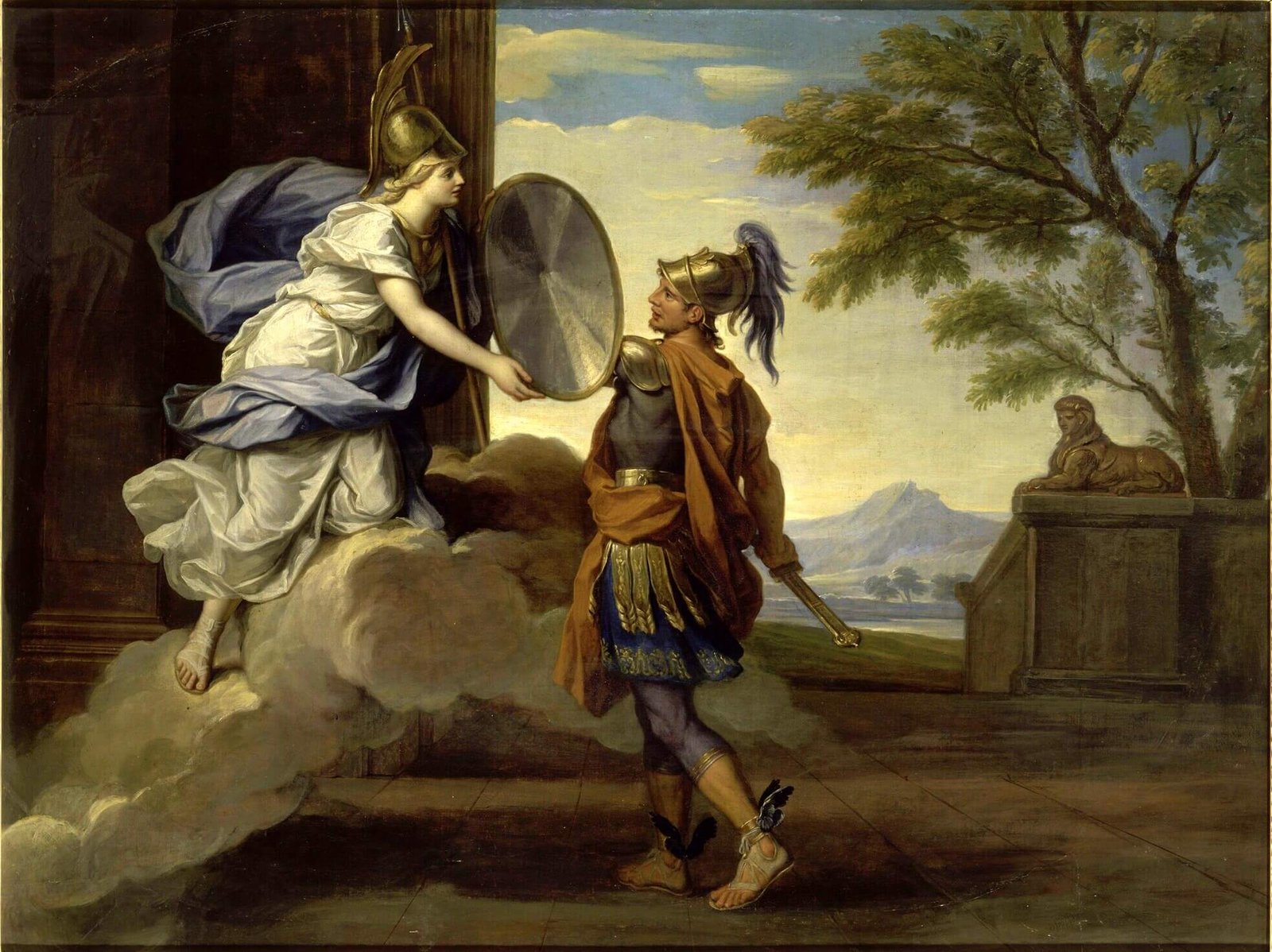
Perseus was always free of wicked moral archons such as envy, vanity or greed. He used the power of Medusa’s head and turned the suffering of humanity (Atlas) into a mountain. Afterwards he transformed the envious hordes of enemies and the wicked king of Seriphos, into stones. One single person, empowered by the power of truth and the force of demolished acts of tyranny (The head of medusa) can manage to eradicate the evilest calamities of humankind. For that reason, the most impressive strength of humanity is intelligence and wisdom.
Therefore, and as the goddess of wisdom that embodies science, art and philosophy, Athena is the way of complete freedom and prosperity. Insofar as the absolute material freedom can be achieved by the means of science and technological inventions. In fact, the liberation of humankind from its diseases, suffering, poverty and all other kind of limits is possible due to science and its marvelous inventions.
Do you want to live eternally young and rich? To cross the universe itself from one border to another? Nothing is unreachable for the goddess of wisdom!
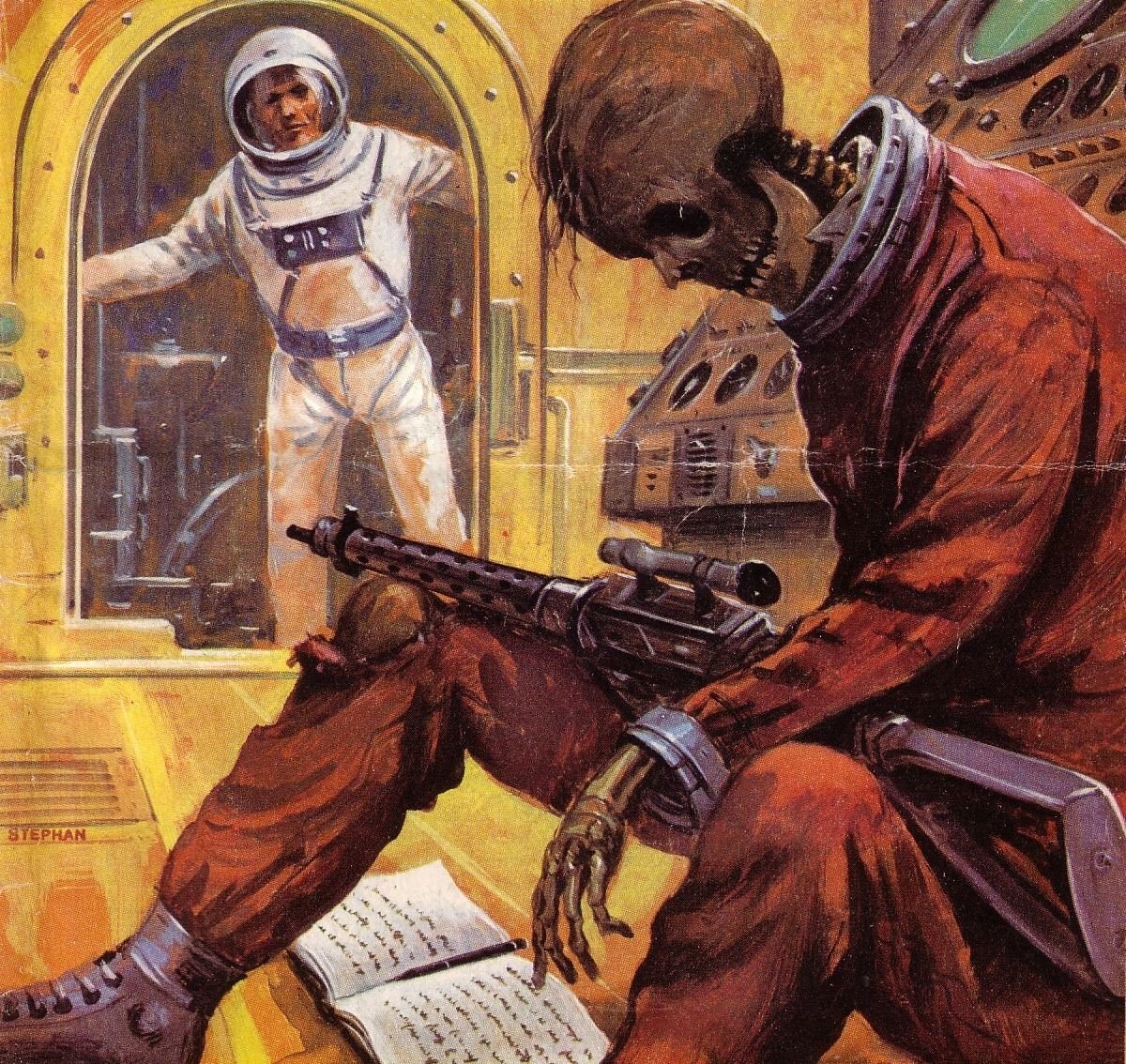
On the other side the immaterial freedom is being reached by virtue of art and philosophy. The man acquires honor, losing his envy, vanity, credulity and fears. His mind and spirit are stronger and much more valuable.
The greatest political ideology begins to take shape. It’s the Ancient ideology of complete freedom, based on physical and spiritual absence of archons. Therefore it must be reached through the progress of wisdom and trade. The perfection and progress of philosophy, art and science. Its name is Athena’s Anarchism.
Athena’s Political system of Chaturanga (Chess)
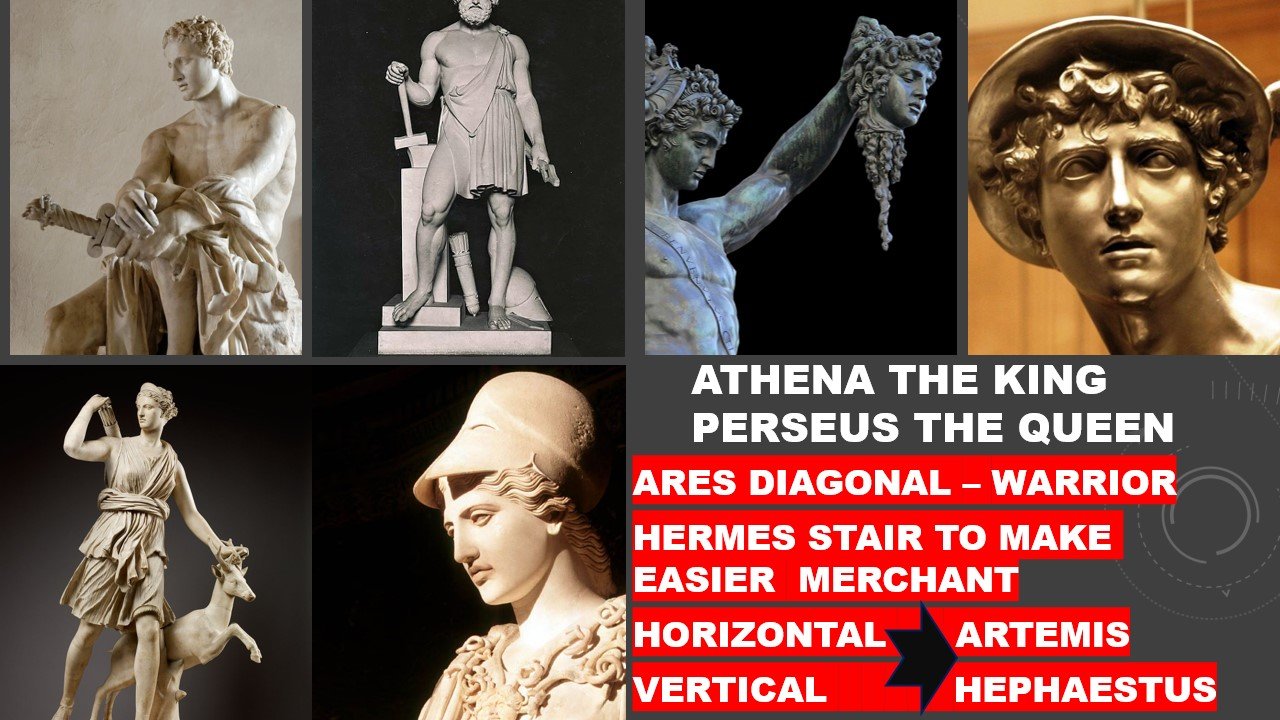
Let’s imagine that we have a high mount to climb. The top of the mount has a very significant wondrous plane surface with great abundance of splendid blooming flowers, fragrant herbs, a creep of clean water and an abandoned mine with gold, silver, diamonds and other important resources, which could be used to make us rich, happy and prosperous.
The Mount itself symbolizes the social harmony, welfare, freedom and justice. It is the embodiment of the Ideal State of Athena – the perfect free society, without pain, suffering, humiliation and poverty. A better Olympus without Zeus for simple average people, whom Prometheus had brought the fire.
That being so, we want to climb this awesome Mount, but have no opportunity to displace all our equipment at the same time. In fact, the top of the mount is so much of astonishing and large, that we decided to set up a new town on it. But there is no way to move all our citizens and utensils up there.
For that reason, we have decided to send several persons with the first part of equipment and build a comfortable stairway along the mount slop. In order to permit the rest of our citizens to reach its top, without peril and painful complications.
The bishop or Gaja as the warrior
The first persons, whom we send to colonize the mount and displace the equipment have to be strong, tough and athletic. The essence of these people is strength, endurance and vigor.
The primal nature of warriors, who have to prevail over difficult situations and conflicts is their physical might. The diagonal line could be the representation of such a nature in Geometry. For that reason the diagonal line of the bishop in chess or of the Gaja in Chaturanga (ancient Indian chess) personifies the strength of the warrior. It is the embodiment of physical might, which must be used to prevail over an inclined surface of a mountain.
⁄ – Diagonal Line of the Warrior. Strength, vigor, and endurance. Ares and Theseus, as the most prominent legendary warriors, whom had helped or subjugated the goddess Athena.
That being so, the Ideal State requires an invincible army of warriors, guards or policemen. War machinery, robots and weaponry. This is Ares.
Thereupon the left bishop or Chaturanga’s Gaja is Ares. He defends the Ideal State physically. Thus, he is invincible and fearless.
Theseus is the right Gaja or bishop, since he is the embodiment of sports, gymnastics and might of an athlete. The worldwide proliferation of sporting, healthy way of life is essential. Thus, the Ideal state of Athena must arrange worldwide competitions and sporting contests. The youth of the nation requires the establishment of impressive gymnasiums, where to practice athletics the best possible way.
Therefore Theseus embodies the public health and vitality for the Ideal state of Athena. Mens sana in corpore sano: in a healthy body lives a healthy mind. Every single man can be a hero of impressive strength and valour, if he trains and works enough.
However, Theseus will also replace Perseus, after his death. The half-son of Poseidon also embodies the way of the pawn towards the queen. He is the chief director, that proved his finest value and intelligence inside the public enterprises of the Ideal state.
The knight (Horse) or Ashva as the merchant
Henceforth, after having established the settlement on the top of the mount, the architects and workers had designed and built a beautiful, usable stairway, made of stones and rock. They finished the most important part of it in a record time. Thus, the major part of the citizens managed to go up the stairs, without danger.
That being the case, the geometry of the stairstep represents another social and political function. The purpose of a stairway and its steps is to facilitate the ascension. Thus, to make easier the life of each person, permitting the ascension of the entire society. In such a way as the merchants help people with their fancy merchandise, contributing to comfortable life and social prosperity by dint of their products, employment and taxes.

Owing to the trade, commerce and craftsmanship, the progress and the prosperity of the Ideal State is being guaranteed from the first moment. The geometry of the step describes the essence of this aid – to make easier and more comfortable the life of people.
In fact, the intersection of the vertical and horizontal line constitute the geometry of a step. It depicts the movement of a horse (knight) in chess and Ashva (Horse) in Chaturanga: ┌
There must be many, many steps to make the stairway be complete and usable. Certainly it’s a clear reference to the free market, great number of merchants and the institutes of trade. The government should incentivize the appearance of many new traders and entrepreneurs, protecting their integrity and freedom of entrepreneurship. It doesn’t matter, which is your race or social status. There are no slaves in the Ideal State of Athena, so everyone can become a merchant and successful trader.
The great number of Small-to-Medium private enterprises are essential for the wealth and freedom of people.
┌ Ashva (Horse) in Chaturanga (moves like a knight in chess). Its social function is to help people and make the ascension easier: Hermes and Prometheus.
Hermes is the right horse or merchant. He embodies the set of private merchants and private trade, protected and incentivized by the state through the implementation of low taxes, public bank credits and complete freedom of entrepreneurship.
Prometheus is the left horse or merchant in Athena’s system of Chaturanga. He embodies the set of big public companies and many free associations, such as the agricultural and the fishing. Thereupon, the free associations of agriculture can guarantee the fair price of vegetables and fruits, providing high salaries to agricultural workers.
Large number of fields and agricultural areas must be given into use to the free association of people. The state will provide a chief technician to each one of them, working with incentives and decent salary, which will depend on the results of the harvest and exploitation.
No piece of fruit or vegetable will be smashed to raise prices and none of the fields will be abandoned with such a purpose. The numerous public markets will buy and sell at fair price. All the workers will be able to join and abandon freely the free association. In addition, the income, obtained from the sales will determine the amount of their salary. In essence, it will be very high because the numerous local public markets will acquire at just price. The markets will be full of luxury, abundance and tasteful original food.
The price of purchase to the agricultural areas and the price for sale will be determined and fixed yearly as the point of reference by the government of the state, with a purpose to guarantee the abundance of food and its affordable just cost. Every covered surface and public market will have its own high-quality prepared dishes. Such as salads, aperitifs, hot and cold meals, to be purchased and taken home. Impressive public restaurants with amazing imaginative cuisine have to use the plentiful amount of fruits and vegetables.
Perseus will found many public industries and companies. They will function as private companies, with incentives and pluses for the managers and directors in chief, who will be fired or rewarded, depending on the results and profits of the company.
The main mission of public companies must be the creation of the most awesome products; the highest benefits and lowest costs. The profits of public enterprises will be destined to increase their potential and also to satisfy the social needs and to increase the lifelong pluses or salaries for every inhabitant and citizen of the nation. Each one of the citizens should be working, studying or being retired, in order to earn this monthly remuneration.
The rook or Ratha: Great advance and harmony
After having built their first dwellings on the top of the Mount and having exploited the mines, full of gold and silver, the inhabitants wanted to lift down the precious minerals and other works of handicraft. Insofar as they needed to sell and exchange them in the market for some new necessary products. However it turned out to be too complicated and tiring.
Furthermore, the frequent ascension by the stairway resulted to be exhausting for the simple citizens of Athena’s Mount. So they asked the philosophers and scientists to invent an elevator, which would lift and descend persons and objects from the Mount. The scientists thought a lot and had improved the Archimedean spiral gear. They had invented an awesome mechanism able to transport things and persons up and down, through the use of the new mechanic engine, which functioned with electricity.
The geometry of the elevator is the vertical line of quick progress and a horizontal line of a platform, where rest the persons and objects to be transported.
┴ , It embodies the quick vertical ascension, related to fast progress and impressive economic advance, obtained from an important kind of social oraganization, which can improve the life of the entire society in a great way. The vertical movement of the rook (Ratha in chaturanga) has no top of the horse ┌. Therefore it symbolizes an improvement without a limit. Something that would ameliorate enormously the human society. The horizontal movement of the rook or Ratha in chaturanga symbolizes the rest and harmony. Since it is typical of the plane position, there people might stand or sleep.
There are two rooks in Athena’s chess: Hephaestus and Artemis. The both deites have a strong relation with the end of the world and the myth of the Babel Tower. As a matter of fact, people frequently denominated the figure of rook as the tower.
Artemis – is the goddess of natural world and the left Ratha (Rook). The horizontal line of the rook represents the protection and restauration of the environment and non-contaminating free energy: The great rest for the humankind, such as clean air and water. On the other side, its vertical line or movement embodies the great education, based on science, art and philosophy, so the children can grow up as very intelligent and responsible adults. Thus, they will be able to reach great success in life and behave properly outside the city. It’s an allusion to the Chaturanga’s duality and the rook of Hephaestus, which enhances the inner side of the city.
Thereupon, if no one stops the contamination of the natural world, the babel tower of humankind will fall down and the civilization of the man will come to an end. On the other side, building the babel tower of natural world, symbolizes the use of free non-contaminating energy and the creation of non-chargeable electric Tesla automobiles. Also the cleaning of the atmosphere and rivers from its pollution. As a result, it would provoke the rage of Zeus – these nefarious capitalist people, who would do everything to make the tower of Artemis fall down, like the Babel’s.
Hephaestus enhances the inner side of the city and turns out to be the right Ratha (Rook). The vertical line of this rook symbolizes the democratic just jurisdiction, carried out by the corpse of true philosophers, who are impartial and objective in their decisions. Thus, it would have been of a great advance for the society of Ancient Greece.
The horizontal line of Hephaestus’s rook symbolizes the big rest and beauty for the nation of the Ideal State of Athena. Astonishing buildings and awesome houses, smart city’s engineering and amazing works of sculptors and carpenters, being spread all around the perfect polis, plentiful of blooming gardens, wonderful fountains and lakes, flamboyant flowers and greenish trees. Every single building is a great masterpiece, adorned with amazing paintings, artifacts and statues. You can find a personal set of sculptures in every courtyard. Large splendorous flats are being sold to all the inhabitants at very affordable, low price. Inasmuch as the president founder, named Perseus cares about the inhabitants of the Ideal State.
The queen and the king: Perseus or Theseus and Athena
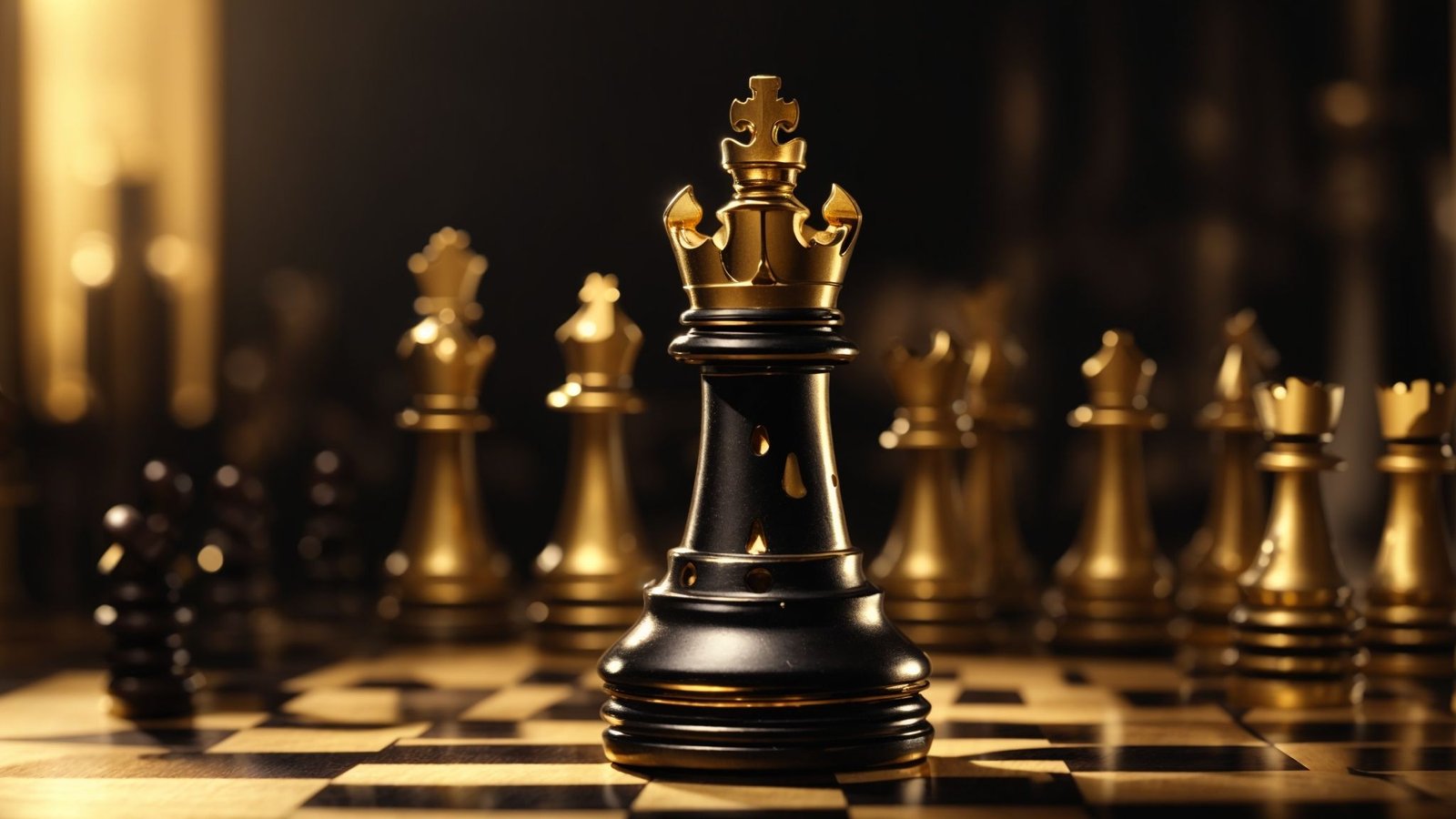
After having spread their influence all around Ancient Greece, the government of the Mount had decided to perpetuate its splendorous democratic power for the sake of people and their prosperity. For such a reason, the greeks decided to have a government of visionaries, elected democratically every four years.
This council of Athena is constituted by the most prominent and acclaimed scientists and the most august, visionary artists (including writers). On the other side, every school and university has its education, strongly based on science, art, philosophy and military disciplines. The most prominent students obtain the rank of Perseus and Athena, according to their own choice.
That being so, Perseus has to be a sportsman, a philosopher, a merchant and an artist or scientist. Greater is the achievement of such a person, greater is his rank. Every four years, citizens who have the greatest rank of Perseus can propose themselves for the elections, which is considered to be the highest honor. From all the candidates with the highest rank of Perseus, one is going to be elected democratically, as a president of the Ideal State. The same thing is being done for the council of Athena, which will be working along Perseus every four years.
Perseus is the queen of chess or Mantri in chaturanga, the president of the state. He needs to lead public companies and create wealth for the citizens of the ideal State. He is the embodiment of just, genius, honorable person, fighting for the ideals of Athena – the attainment of complete freedom through the ways of art, science and philosophy. The queen moves in diagonal, vertical and horizontal direction. Because Perseus is a warrior, a great merchant and great philosopher.
Perseus must work together with a council of Athena – a group of expert scientists, visionary artists and great thinkers, who will make laws and reforms for the scientific researches, education, architecture and other social projects.
Along Perseus, for the year of the elections (if there is such a person), all other candidates, having the public status of Theseus will be proposed, as candidates for the presidency, by the mandate of constitution. Perseus is an exceptional example of great private person, that can be a president, because of his amazing achievements, as entrepreneur, visionary artist or great scientist.
Thus Theseus is not only the symbol of sports and gymnastics in the Ideal State of Athena, but a political substitute of Perseus, in case of having demonstrated his great worth.
Theseus himself and his story makes a strong reference to a man with a certain political destiny. A half-son of an Athenian king and half-son of Poseidon, he passed nearby the six entrances to the underworld, and had slain all its monstrous guardians and villains.
Such an allusion might refer to a strong man of ideals, who worked in public institutions, or enterprises of the Ideal State, managing the most impressive results, as a director or manager in chief. Nonetheless, Theseus will be elected, as a president every four years with one single option for the re-election. All the candidates for the government can have their own political ideologies and plans of development, but always for the sake of the nation and its steady prosperity.
The Theseus have to be sportsmen and of an adult or middle age. Important engineers in chief, the best directors of state-owned companies, or distinguished scientists, that had been working for the nation with great success. They must be able to lead the public companies and industries of the entire country.
Athena is the personification of science, art and philosophy, as the set of knowledge, wisdom and disciplines to be considered as the most important for the humankind. Athena is the way to reach complete freedom. If Athena is checkmated, the game of Chaturanga (Chess) is over. As a metaphor of human progress, being abruptly stopped, because the philosophy, art and science had disappeared and don’t exist anymore.
An impressive example of chaturanga’s stalemate (checkmate in chess) is the Medieval period in Europe, when the Catholic Church had strongly forbidden and controlled the expression of free thinking, philosophy, science and art. The inquisition had been condemning scientists and burning books with new scientific theories. The art needed to be banal and religious. Great philosophical thoughts had been changed by catholic or Orthodox faith. As a result, the progress of humanity had stopped for a long thousand years and the Europeans (also the eastern Europeans as a result of Orthodox faith) had seen nothing but poverty, misery and suffering. It was the tomb of human civilization.
